Cod liver oil is the most popular health supplement, and as a result of this many companies are manufacturing their own brands and trying to make a cheaper and more affordable product. By reducing production costs the resulting product is often poor quality, but do you know the difference between quality and price? This article will explain how cod liver oil is made, and how to identify the best cod liver oil.
It starts with the fish
As with all nutritional products, the final product cannot be any healthier than the raw materials they are made from, which in this case are cods livers. Livers can be sourced from either farmed fish or wild fish, and the quality of the liver differs greatly between the two sources. Farmed fish are fed a diet derived from fish meal, vegetable oils and plant matter, which is often made from waste materials from the food industry. These foods are often low in micro-nutrients and the feed is tailored to the macro-nutrient requirements of the fish, not the micro-nutrients. This often results in cod with poor health, with low levels of omega-3 fatty acids in their liver, and a higher than normal level of heavy metals in their body such as methyl-mercury and cadmium. Farmed fish are very cheaply sourced, which reduces the cost of production, but the presence of heavy metals and low omega-3 content reduces the quality and nutritional value.
Wild fish, which are able to eat their natural diet are much lower in toxins, and the omega-3 content of their liver is much higher than farmed fish. They are able to exercise more as they are not enclosed, and must catch their food, which means that they will not contain any undesirable fatty deposits in their liver. Oil obtained from these fish is much more nutritious, and so a good cod liver oil supplement will be made from these fish.
How cod liver oil is extracted
Wet processing 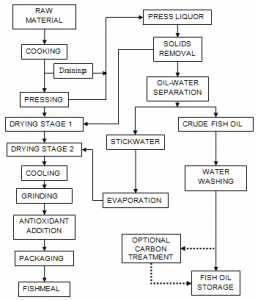
This is a very commonly used extraction method, and produces both fish oil and fish-meal. A diagram showing the stages of wet processing can be seen on the right. From the diagram you can see that there is a cooking stage and a pressing stage which greatly impacts the quality of the oil. The high heat (up 95 degrees) and pressure creates a highly reactive environment, which rapidly oxidizes essential fats with oxygen which is present in the air, rendering them nutritionally useless and toxic. The optional carbon treatment stage is used to remove harmful chemicals (such as heavy metals) from the oil, but can also remove vitamin A and D too. If farmed fish are used to produce this oil, then it is important that the carbon treatment is carried out to remove the high levels of toxins. Often synthetic versions of vitamin A and D are added to the oil if it has been carbon treated, which are less bio available than the naturally occurring vitamins.
This is not an ideal treatment method, because it damages a the essential omega-3 fatty acids, and can remove the naturally occurring vitamin D and A.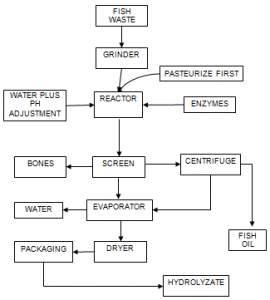
Enzymic hydrolysis
This method is not commonly used as it is not economical. It uses naturally occurring enzymes to break down the liver cells and release the oil. The pasteurization stage at the start can cause oxidation of the fatty acids in a similar way to that of high pressure and heat, but to a lesser extent. Fish oil extracted via this method will contain naturally occurring vitamin D and D, which makes this oil more desirable than wet processed oil.
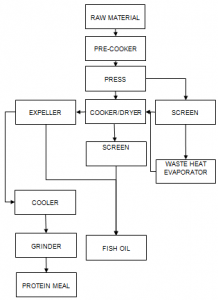
Dry rendering
A similar method to wet processing, dry rendering includes cooking and pressing stages which cause damage to the omega-3 fatty acids. This method producesa product called ‘crude fish oil’, which needs to go further cleaning before it can be used, this cleaning process can further damage vitamins and omega-3 fatty acids, and there are various methods by which it can be cleaned. This is not a particularly popular method, as it can be expensive to conduct.
Acid-alkali process
This method is similar to enzymic hydrolysis, but instead of using enzymes to break down the proteins variations in pHs are used, which makes the process 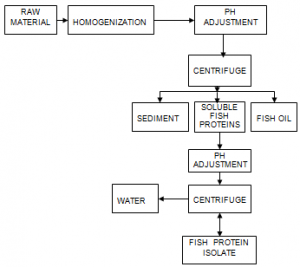 easier to control. As there is no heat or pressure used in this method, it is more desirable than the previous 3 methods discussed as there is minimal damage to the fatty acids from oxidation. The varying pH will cause minimal damage to the omega-3s, but will do more damage to vitamin A and D, meaning that synthetic vitamins are often added to the oil afterwards.
easier to control. As there is no heat or pressure used in this method, it is more desirable than the previous 3 methods discussed as there is minimal damage to the fatty acids from oxidation. The varying pH will cause minimal damage to the omega-3s, but will do more damage to vitamin A and D, meaning that synthetic vitamins are often added to the oil afterwards.
Salt water fermentation
Salt water fermentation is the traditional method for fish oil extraction, and involves adding ground cod liver to a barrel with sea water for an extended period of time. The liver cells are broken down by bacteria, which releases the oil ready for processing. As no heat, pressure or extreme pHs are used in this method, the omega-3s and vitamins are undamaged. The bacteria which break down the liver cell walls produce other co-factors, in particular co-enzyme Q10 (ubiquinone), which is present in the final product, and is known for its benefits for the cardiovascular system. This process can take up to a year to complete, which adds to the production costs, but preserves all the nutritional content of the oil.
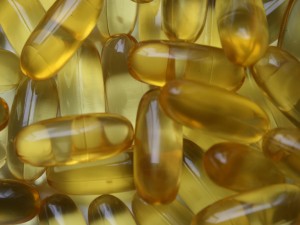
Image Courtesy of MyDigitalSLRCamera
Synthetic vitamins vs naturally occurring vitamins
Vitamins which are produced naturally are often found with various metabolites of the vitamins, which aid with its absorption and utilization in the body. This is similar to the way vitamin C is often blended with bioflavinoids, as they help the body absorb and use vitamin C. Synthetic vitamins do not come with these metabolites, and can also be bonded to other molecules to help stabilize or extract them, which makes them harder to absorb and utilize in the body. Some synthetic vitamins have actually been shown to be toxic because of they way they have been stabilized. This means that a cod liver oil which contains contains vitamins in their natural form are much more desirable and hold more nutritional value than cod liver oil supplements which have had synthetic forms added.
Storage and container
Once the cod liver oil is made into a supplement form and encased inside a gel capsule, it is still vulnerable to oxidative damage. Exposure to UV light, or pending a prolonged time in a warm environment will cause oxidation of the omega-3 fatty acids. This is very slow, but over a long period of time the damage builds up. this is why it is important to ensure that cod liver oil capsules are contained in a dark bottle which UV light cannot penetrate, and kept in a cool place, ideally a refrigerator.
Summary
The best cod liver oil will be sourced from wild fish and contain vitamin A and D in their naturally occurring form, as this ensures the body can absorb them and utilize them efficiently. It is also important to ensure that the omega-3s are not damaged during the extraction process, as this will render them nutritionally useless. The fermentation process provides additional nutrients such as co-enzyme Q10 (ubiquinone) which offer additional health benefits, and also doesn’t cause oxidative damage to the omega-3s. To prove quality, some manufacturers have their products independently tested for content of omega-3s vitamin A and D and ubiquinone to show they are present in sufficient quantities. If a manufacturer doesn’t make independent quality tests public, it is an indication that their product is not high quality.

